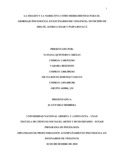Please use this identifier to cite or link to this item:
https://repository.unad.edu.co/handle/10596/24448Full metadata record
| DC Field | Value | Language |
|---|---|---|
| dc.contributor.advisor | Herrera, Juan Pablo | - |
| dc.coverage.spatial | cead_-_Sogamoso | spa |
| dc.creator | Quintero Cabezas, Tatiana | - |
| dc.creator | Redondo, Yajaira | - |
| dc.creator | Jiménez Tamayo, Silvia Roció | - |
| dc.date.accessioned | 2019-03-20T22:04:15Z | - |
| dc.date.available | 2019-03-20T22:04:15Z | - |
| dc.date.created | 2018-12-24 | - |
| dc.identifier.uri | https://repository.unad.edu.co/handle/10596/24448 | - |
| dc.description.abstract | Este ejercicio académico plantea el análisis de relatos de vida, tomados del libro, Voces: Relatos de violencia y esperanza en Colombia, editado por el Banco mundial en el año 2009, sobre historias reales en el marco del conflicto armado; estableciendo un escenario de análisis y reflexión de la intervención y acción psicosocial. Desde la narrativa, se suscitan estrategias de auto comprensión y re significación de situaciones victimizantes; en donde el individuo y las comunidades reconocen capacidades y habilidades resilientes, desarrollan proyectos de vida dignificantes y de calidad. La narrativa tiene una función que traspasa las barreras de la expresión y la comunicación de una realidad explícita y contundente, propendiendo la visualización de lo invisible, el reconocimiento del entorno, del sí mismo, de los demás y del entorno a través de una imagen, un texto, etc. Conlleva a la creación y la valoración de símbolos, de cultura, de percepción y subjetividades e intersubjetividades en torno a las dinámicas de violencia. El Acompañamiento Psicosocial en escenarios de violencia, recurre a diferentes estrategias de intervención tanto en lo individual como en lo colectivo, en donde la expresión y manifestación del evento victimizante, se da desde las lógicas y subjetividades. El papel del profesional, es fundamental en fomentar e impulsar a través del arte de preguntar y la catarsis que a la postre posibilita la manifestación del dolor y la re significación del sufrimiento, en donde surge y se visibiliza, la capacidad de afrontamiento activo, de un individuo y la población, pensándose ya no como víctimas, sino con una identidad de sobrevivientes. Mediante el presente trabajo académico la Universidad Nacional Abierta y a Distancia (UNAD), forma en los estudiantes del programa de psicología, competencias que permiten una mirada reflexiva frente a los cambios sociales que ha generado el conflicto armado en Colombia, respondiendo a la realidad socio histórica del país en el marco del post conflicto. Así mismo, contribuye a la construcción de futuros profesionales con capacidad de abordar, interpretar y actuar desde el enfoque narrativo en diferentes contextos y realidades violentas, con la implementación de estrategias con objetivos y metas claras lograr el impacto deseado. | spa |
| dc.format | spa | |
| dc.format.mimetype | application/pdf | spa |
| dc.language.iso | spa | spa |
| dc.publisher | Universidad Nacional Abierta y a Distancia UNAD | spa |
| dc.title | La imagen y la narrativa como herramientas para el abordaje psicosocial en escenarios de violencia. municipio de Sibaté, Astrea Cesar y Paipa Boyacá. | spa |
| dc.type | Diplomado de profundización para grado | spa |
| dc.subject.keywords | Análisis de relatos | spa |
| dc.subject.keywords | Enfoque narrativo | spa |
| dc.subject.keywords | Estrategias de intervención | spa |
| dc.description.abstractenglish | This academic exercise proposes the analysis of life stories, taken from the book, Voices: Stories of Violence and Hope in Colombia, edited by the World Bank in 2009, on real stories in the context of the armed conflict; establishing a scenario of analysis and reflection of the intervention and psychosocial action. From the narrative, strategies of self-understanding and re signification of victimizing situations are generated; where the individual and the communities recognize resilient capacities and abilities, develop dignifying and quality life projects. The narrative has a function that transcends the barriers of expression and communication of an explicit and forceful reality, promoting the visualization of the invisible, the recognition of the environment, of the self, of others and of the environment through an image, a text, etc. It leads to the creation and valuation of symbols, culture, perception and subjectivities and intersubjectivities around the dynamics of violence. Psychosocial Accompaniment in scenarios of violence, resorts to different intervention strategies both individually and collectively. Where the expression and manifestation of the victimizing event, is given from the logic and subjectivities. The role of the professional is fundamental in fostering and promoting through the art of questioning and catharsis, which ultimately enables the manifestation of pain and the re-meaning of suffering, where the ability to cope actively, to arise and become visible, an individual and the population, thinking now not as victims, but with a Survivor Identity. Through the present academic work the National Open University and Distance (UNAD), form students in the psychology program, skills that allow a reflective look at the social changes that have generated the armed conflict in Colombia, responding to the socio-historical reality of the country in the post-conflict context. Likewise, it contributes to the construction of future professionals with the ability to approach, interpret and act from the narrative approach in different contexts and violent realities, with the implementation of strategies with clear objectives and goals to achieve the desired impact. | spa |
| dc.subject.category | Psicología | spa |
| dc.rights.accesRights | info:eu-repo/semantics/openAccess | spa |
| dc.rights.acceso | Abierto (Texto Completo) | spa |
| Appears in Collections: | Diplomado Acompañamiento Psicosocial en Escenarios de Violencia | |
Files in This Item:
| File | Description | Size | Format | |
|---|---|---|---|---|
| srjimenezt.pdf | La imagen y la narrativa como herramientas para el abordaje psicosocial en escenarios de violencia. municipio de Sibaté, Astrea Cesar y Paipa Boyacá. | 473.62 kB | Adobe PDF |  View/Open |
Items in DSpace are protected by copyright, with all rights reserved, unless otherwise indicated.
